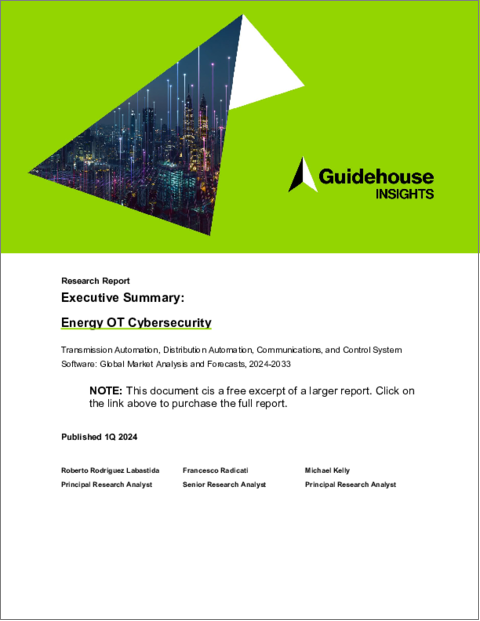|
|
市場調査レポート
商品コード
1455865
エネルギー業界のOTサイバーセキュリティ - 送電オートメーション、配電オートメーション、通信、制御システムソフトウェア:世界市場の分析と予測 (2024~2033年)Energy OT Cybersecurity - Transmission Automation, Distribution Automation, Communications, and Control System Software: Global Market Analysis and Forecasts, 2024-2033 |
||||||
|
|||||||
| エネルギー業界のOTサイバーセキュリティ - 送電オートメーション、配電オートメーション、通信、制御システムソフトウェア:世界市場の分析と予測 (2024~2033年) |
|
出版日: 2024年03月27日
発行: Guidehouse Research
ページ情報: 英文 28 Pages; 14 Tables, Charts & Figures
納期: 即納可能
|
全表示
- 概要
- 図表
- 目次
ユーティリティ企業は、重要インフラに接続性を追加することで、グリーンイニシアティブの促進や回復力の向上、障害回復の容易化を実現してきました。しかし、接続性が高まったことで攻撃対象も広がり、悪意ある行為者がデータを盗んだり、ユーティリティ企業の機器を破壊したりするようになりました。その結果、ユーティリティ企業内の運用技術 (OT) 組織は、IT部門に追随して、サイバー攻撃による被害を軽減するために、より高度なサイバーセキュリティ管理を実施しなければならなくなりました。
同時に、製造業やユーティリティのような部門に対するサイバー攻撃が近年急増しており、より巧妙になっています。サイバーセキュリティの研究者は絶えず新しい脅威グループや脆弱性を発見する一方、攻撃者は金銭を強奪したり業務を妨害したりする新しい方法を絶えず考案しています。例えば、研究者によると、2023年にはランサムウェアの攻撃総額が初めて10億米ドルを超えました。これは、脅威者がより多くの攻撃を仕掛け、1回の攻撃により多くの金銭を要求したのが原因です。
当レポートでは、エネルギー業界のOT分野、特に送電オートメーション、配電オートメーション、通信、産業用制御システムの分野におけるサイバーセキュリティに焦点を当てています。サイバー攻撃を防止・軽減するための技術と戦術の現状を論じ、世界各地のエネルギー業界向けOTサイバーセキュリティ支出額の予測を示しています。
目次
第1章 エグゼクティブサマリー
第2章 市場の課題
- OTセキュリティの概要
- 促進要因
- 抑制要因
- その他のビジネス上の課題
第3章 業界のバリューチェーン
- 競合情勢
- 企業合併・買収 (M&A)
- ビジネスモデルの進化
第4章 市場予測
- 予測手法
- 世界市場の展望
- 北米
- 欧州
- アジア太平洋
- ラテンアメリカ
- 中東・アフリカ
第5章 結論・提言
- 3つの大きなポイント
- 推奨事項
- 資産所有者
- サイバーセキュリティベンダー
第6章 頭字語と略語一覧
第7章 目次
第8章 図表
第9章 調査範囲
第10章 情報源、調査手法、注釈
List of Tables
- Energy OT Cybersecurity Revenue by Region, World Markets: 2024-2033
- Energy OT Cybersecurity Revenue by Category, World Markets: 2024-2033
- Energy OT Cybersecurity Revenue by Category, North America: 2024-2033
- Energy OT Cybersecurity Revenue by Category, Europe: 2024-2033
- Energy OT Cybersecurity Revenue by Category, Asia Pacific: 2024-2033
- Energy OT Cybersecurity Revenue by Category, Latin America: 2024-2033
- Energy OT Cybersecurity Revenue by Category, Middle East & Africa: 2024-2033
List of Figures
- Energy OT Cybersecurity Revenue by Region, World Markets: 2024-2033
- Energy OT Cybersecurity Revenue by Category, North America: 2024-2033
- Energy OT Cybersecurity Revenue by Category, Europe: 2024-2033
- Energy OT Cybersecurity Revenue by Category, Asia Pacific: 2024-2033
- Energy OT Cybersecurity Revenue by Category, Latin America: 2024-2033
- Energy OT Cybersecurity Revenue by Category, Middle East & Africa: 2024-2033
Pictorial Representation of the Industry Value Chain
Adding connectivity to critical infrastructure has enabled utilities to implement green initiatives, improve resilience, and manage faults more easily. However, increased connectivity has also expanded the attack surface for malicious actors to steal data or wreck utilities' equipment. As a result, operational technology (OT) organizations within utilities have had to follow their IT colleagues in implementing greater cybersecurity controls to reduce the damage from cyberattacks.
At the same time, cyberattacks against sectors like manufacturing and utilities have grown sharply in recent years and are becoming more sophisticated. Cybersecurity researchers continually discover new threat groups and vulnerabilities, and attackers constantly devise new ways to extort money or disrupt operations. For example, researchers say that in 2023, ransomware attacks totaled more than $1 billion for the first time, as threat actors launched more attacks and demanded more money per attack.
This report focuses on cybersecurity in the energy OT sector, specifically in the areas of transmission automation, distribution automation, communications, and industrial control systems. It discusses the state of play in terms of technologies and tactics to prevent and mitigate cyberattacks, and presents forecasts for energy OT cybersecurity spending in all world regions.
Table of Contents
1. Executive Summary
- 1.1 Introduction
- 1.2 Report Scope
- 1.3 Global Forecast
2. Market Issues
- 2.1 OT Security Overview
- 2.2 Drivers
- 2.3 Barriers
- 2.4 Other Business Issues
3. Industry Value Chain
- 3.1 Competitive Landscape
- 3.1.1 Mergers and Acquisitions
- 3.1.2 Business Model Evolution
4. Market Forecasts
- 4.1 Forecast Methodology
- 4.2 Global Outlook
- 4.3 North America
- 4.4 Europe
- 4.5 Asia Pacific
- 4.6 Latin America
- 4.7 Middle East & Africa
5. Conclusions and Recommendations
- 5.1 Three Big Takeaways
- 5.2 Recommendations
- 5.2.1 Asset Owners
- 5.2.2 Cybersecurity Vendors





